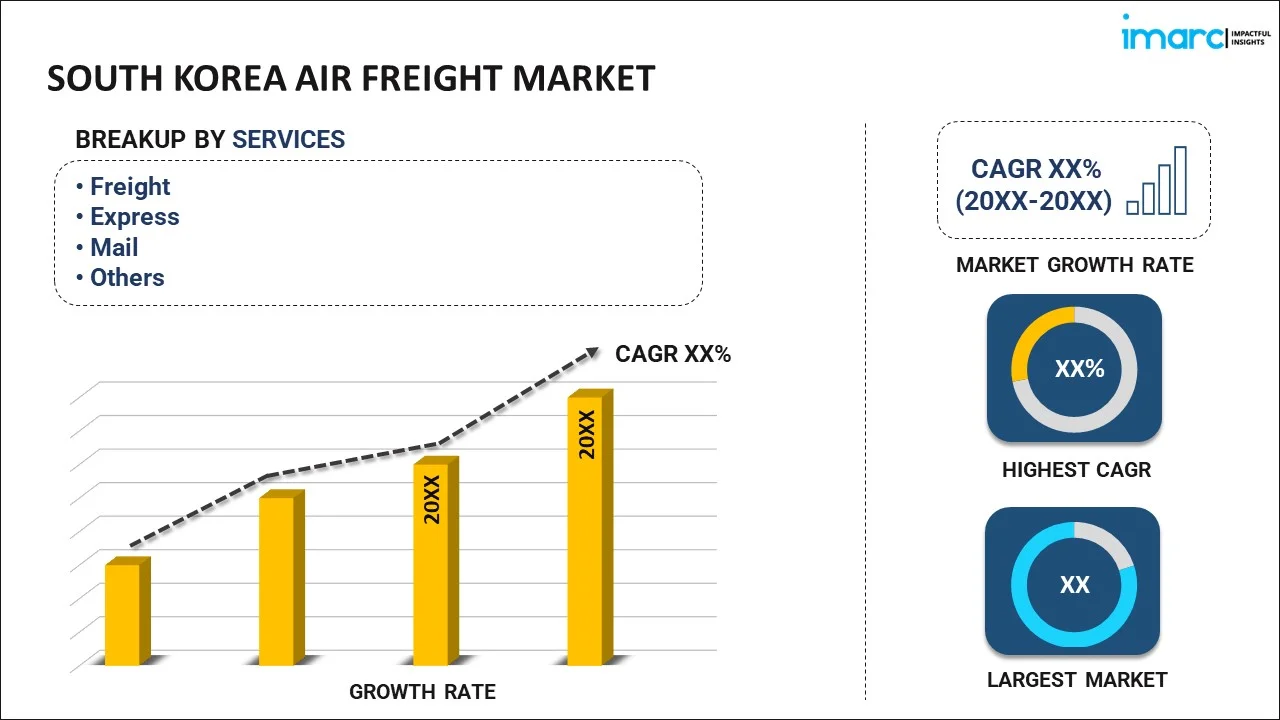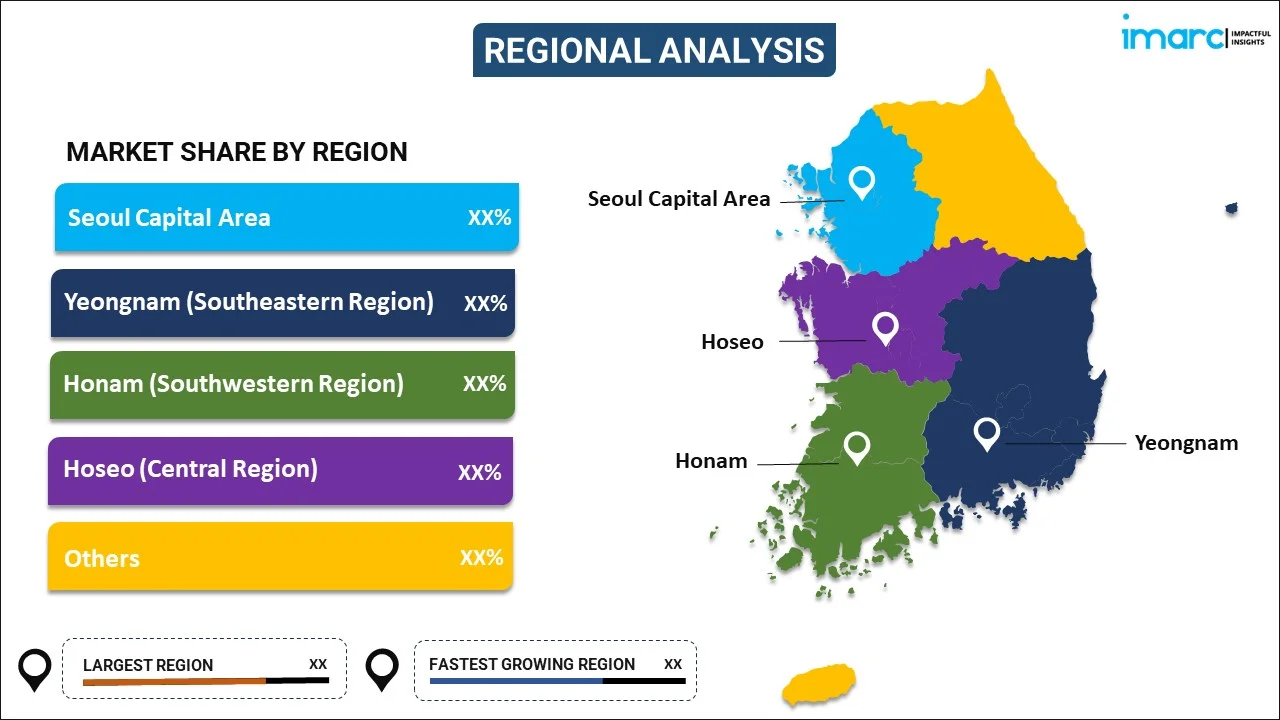
South Korea Air Freight Market Report by Service (Freight, Express, Mail, and Others), Destination (Domestic, International), End User (Private, Commercial), and Region 2025-2033
Market Overview:
The South Korea air freight market size is projected to exhibit a growth rate (CAGR) of 2.12% during 2025-2033. The reliance on exports requiring air freight services to transport goods to international markets, the increasing transport of cutting-edge technology products, including semiconductors, smartphones, and consumer electronics, and the establishment of strong trade partnerships with countries around the world represent some of the key factors driving the market.
|
Report Attribute
|
Key Statistics
|
|---|---|
|
Base Year
|
2024 |
|
Forecast Years
|
2025-2033
|
|
Historical Years
|
2019-2024
|
| Market Growth Rate (2025-2033) | 2.12% |
Air freight, also known as air cargo, refers to the transportation of goods or cargo by aircraft. It is a vital component of the global logistics and supply chain industry, offering a fast and efficient means of transporting goods over long distances. It is known for its speed and efficiency. It allows goods to be transported quickly, often within hours or a few days, compared to other modes of transportation like sea freight or ground transportation, which can take weeks or months. It also provides access to a vast network of airports and destinations worldwide and is suitable for transporting goods to remote or distant locations where other transportation modes may not be as accessible. In addition, air freight is ideal for transporting perishable goods like fresh produce, seafood, flowers, and pharmaceuticals. The temperature-controlled cargo holds of aircraft help preserve the quality and freshness of these products. Industries such as healthcare, automotive manufacturing, fashion, and electronics rely on air freight for time-sensitive shipments. The rapid delivery of components, products, and spare parts is critical for maintaining supply chain efficiency.
South Korea Air Freight Market Trends:
South Korea is known for its export-oriented economy, with a strong focus on industries like electronics, automotive, and manufacturing. This reliance on exports generates a significant demand for air freight services to transport goods to international markets. In addition, the country exports a substantial amount of high-value and time-sensitive products, including electronics, semiconductor components, pharmaceuticals, and automotive parts. Air freight is the preferred mode of transport for these goods due to its speed and reliability. Besides, South Korea has established strong trade partnerships with countries around the world. Air freight facilitates the rapid movement of goods to and from key trading partners, such as the United States, China, Japan, and European countries. Moreover, the growth of e-commerce has led to increased demand for air freight services to handle online retail shipments. South Korean consumers increasingly rely on e-commerce platforms for purchasing a wide range of products, driving the need for quick and efficient deliveries. Additionally, the air freight market benefits from the need to transport cutting-edge technology products, including semiconductors, smartphones, and consumer electronics. Furthermore, South Korea is a significant producer of pharmaceuticals and medical devices. The air freight market plays a crucial role in transporting pharmaceutical products, vaccines, and medical equipment, especially during the COVID-19 pandemic. On account of these factors, the market is expected to witness positive growth in the coming years.
South Korea Air Freight Market Segmentation:
IMARC Group provides an analysis of the key trends in each segment of the market, along with forecasts at the country level for 2025-2033. Our report has categorized the market based on service, destination, and end user.
Service Insights:

- Freight
- Express
- Others
The report has provided a detailed breakup and analysis of the market based on the service. This includes freight, express, mail, and others.
Destination Insights:
- Domestic
- International
A detailed breakup and analysis of the market based on the destination have also been provided in the report. This includes domestic and international.
End User Insights:
- Private
- Commercial
The report has provided a detailed breakup and analysis of the market based on the end user. This includes private and commercial.
Regional Insights:

- Seoul Capital Area
- Yeongnam (Southeastern Region)
- Honam (Southwestern Region)
- Hoseo (Central Region)
- Others
The report has also provided a comprehensive analysis of all the major regional markets, which include Seoul Capital Area, Yeongnam (Southeastern Region), Honam (Southwestern Region), Hoseo (Central Region), Others.
Competitive Landscape:
The market research report has also provided a comprehensive analysis of the competitive landscape. Competitive analysis such as market structure, key player positioning, top winning strategies, competitive dashboard, and company evaluation quadrant has been covered in the report. Also, detailed profiles of all major companies have been provided.
South Korea Air Freight Market Report Coverage:
| Report Features | Details |
|---|---|
| Base Year of the Analysis | 2024 |
| Historical Period | 2019-2024 |
| Forecast Period | 2025-2033 |
| Units | Million USD |
| Scope of the Report | Exploration of Historical and Forecast Trends, Industry Catalysts and Challenges, Segment-Wise Historical and Predictive Market Assessment:
|
| Services Covered | Freight, Express, Mail, Others |
| Destinations Covered | Domestic, International |
| End Users Covered | Private, Commercial |
| Regions Covered | Seoul Capital Area, Yeongnam (Southeastern Region), Honam (Southwestern Region), Hoseo (Central Region), Others |
| Customization Scope | 10% Free Customization |
| Post-Sale Analyst Support | 10-12 Weeks |
| Delivery Format | PDF and Excel through Email (We can also provide the editable version of the report in PPT/Word format on special request) |
Key Questions Answered in This Report:
- How has the South Korea air freight market performed so far and how will it perform in the coming years?
- What has been the impact of COVID-19 on the South Korea air freight market?
- What is the breakup of the South Korea air freight market on the basis of service?
- What is the breakup of the South Korea air freight market on the basis of destination?
- What is the breakup of the South Korea air freight market on the basis of end user?
- What are the various stages in the value chain of the South Korea air freight market?
- What are the key driving factors and challenges in the South Korea air freight?
- What is the structure of the South Korea air freight market and who are the key players?
- What is the degree of competition in the South Korea air freight market?
Key Benefits for Stakeholders:
- IMARC’s industry report offers a comprehensive quantitative analysis of various market segments, historical and current market trends, market forecasts, and dynamics of the South Korea air freight market from 2019-2033.
- The research report provides the latest information on the market drivers, challenges, and opportunities in the South Korea air freight market.
- Porter's five forces analysis assist stakeholders in assessing the impact of new entrants, competitive rivalry, supplier power, buyer power, and the threat of substitution. It helps stakeholders to analyze the level of competition within the South Korea air freight industry and its attractiveness.
- Competitive landscape allows stakeholders to understand their competitive environment and provides an insight into the current positions of key players in the market.
Need more help?
- Speak to our experienced analysts for insights on the current market scenarios.
- Include additional segments and countries to customize the report as per your requirement.
- Gain an unparalleled competitive advantage in your domain by understanding how to utilize the report and positively impacting your operations and revenue.
- For further assistance, please connect with our analysts.
 Request Customization
Request Customization
 Speak to an Analyst
Speak to an Analyst
 Request Brochure
Request Brochure
 Inquire Before Buying
Inquire Before Buying




.webp)




.webp)












